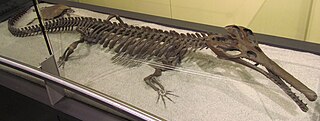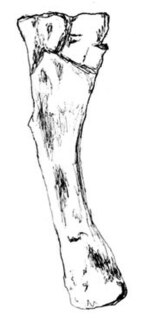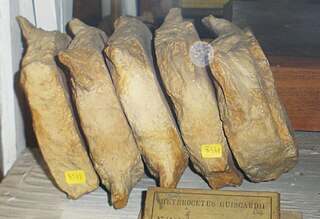 W
WAllosaurus is a genus of large carnivorous theropod dinosaur that lived 155 to 145 million years ago during the late Jurassic period. The name "Allosaurus" means "different lizard" alluding to its unique concave vertebrae. It is derived from the Greek ἄλλος and σαῦρος. The first fossil remains that could definitively be ascribed to this genus were described in 1877 by paleontologist Othniel Charles Marsh. As one of the first well-known theropod dinosaurs, it has long attracted attention outside of paleontological circles.
 W
WApatosaurus is a genus of herbivorous sauropod dinosaur that lived in North America during the Late Jurassic period. Othniel Charles Marsh described and named the first-known species, A. ajax, in 1877, and a second species, A. louisae, was discovered and named by William H. Holland in 1916. Apatosaurus lived about 152 to 151 million years ago (mya), during the late Kimmeridgian to early Tithonian age, and are now known from fossils in the Morrison Formation of modern-day Colorado, Oklahoma, New Mexico, Wyoming, and Utah in the United States. Apatosaurus had an average length of 21–22.8 m (69–75 ft), and an average mass of 16.4–22.4 t. A few specimens indicate a maximum length of 11–30% greater than average and a mass of 32.7–72.6 t.
 W
WBaptornis is a genus of flightless aquatic birds from the Late Cretaceous, some 87-80 million years ago. The fossils of Baptornis advenus, the type species, were discovered in Kansas, which at its time was mostly covered by the Western Interior Seaway, a shallow shelf sea. It is now known to have also occurred in today's Sweden, where the Turgai Strait joined the ancient North Sea; possibly, it occurred in the entire Holarctic.
 W
WBlastomeryx is an extinct genus of musk deer endemic to North America. It lived during the Miocene epoch 20.4—10.3 mya, existing for approximately 10 million years . There may be only one species, Blastomeryx gemmifer.
 W
WCamarasaurus was a genus of quadrupedal, herbivorous dinosaurs. It was the most common of the giant sauropods to be found in North America. Its fossil remains have been found in the Morrison Formation of Colorado and Utah, dating to the Late Jurassic epoch, between 155 and 145 million years ago.
 W
WCanis etruscus is an extinct species of canine that was endemic to Mediterranean Europe during the Early Pleistocene. The Etruscan wolf has been described as a small wolf-like dog. The Etruscan wolf has been accepted as the ancestor of C. mosbachensis that is the ancestor of the gray wolf for a long time. A recent research suggest that C. borjgali from Dmanisi has to be considered the ancestor of C. mosbachensis.
 W
WChampsosaurus is an extinct genus of diapsid reptiles belonging to the order Choristodera, that existed in the Late Cretaceous and Paleogene periods. It consists of seven species: C. albertensis, C. ambulator, C. gigas, C. laramiensis, C. lindoei, C. natator, and C. tenuis. The name Champsosaurus is thought to come from χαμψαι [champsai], and σαύρος [sauros]. The largest species, C. gigas, grew to 3–3.5 m in length.
 W
WCheliderpeton is an extinct genus of temnospondyl amphibian. It lived during the Early Permian in what is now Europe and Germany. Fossils have been found from the Ruprechtice horizon of the Intrasudetic Basin of Bohemia in the Czech Republic, as well as the Saar-Nahe Basin of southwestern Germany. Cheliderpeton had a 16 cm skull, and reached about 65 cm in length.
 W
WDiplocaulus is an extinct genus of lepospondyl amphibians which lived from the Late Carboniferous to Permian periods of North America and Africa. Diplocaulus is by far the largest and best-known of the lepospondyls, characterized by a distinctive boomerang-shaped skull. Remains attributed to Diplocaulus have been found from the Late Permian of Morocco and represent the youngest-known occurrence of a lepospondyl.
 W
WDryptosaurus is a genus of tyrannosauroid that lived approximately 67 million years ago during the latter part of the Cretaceous period in what is now New Jersey. Dryptosaurus was a large, bipedal, ground-dwelling carnivore, that could grow up to 7.5 m (25 ft) long. Although largely unknown now outside of academic circles, a famous painting of the genus by Charles R. Knight made it one of the more widely known dinosaurs of its time, in spite of its poor fossil record. First described by Edward Drinker Cope in 1866 and later renamed by Othniel C. Marsh in 1877, Dryptosaurus is among the first theropod dinosaurs known to science.
 W
WDystrophaeus is the name given to an extinct genus of eusauropod dinosaur from the early Kimmeridgian stage of the Late Jurassic that existed around 154.8 Ma. Its fossils were found in the Tidwell Member of the Morrison Formation of Utah. Its estimated mass is 12 tonnes.
 W
WEpihippus is an extinct genus of the modern horse family Equidae that lived in the Eocene, from 46 to 38 million years ago.
 W
WHeliobatis is an extinct genus of stingray in the Myliobatiformes family Dasyatidae. At present the genus contains the single species Heliobatis radians.
 W
WHeterocetus is a dubious genus of extinct cetacean.
 W
WLysorophus is a genus of Lysorophia, extinct Permian Lepospondyl tetrapods. Most of the specimens are found from North America and attributed to the first formally described species Lysorophus tricarinatus due to the lack of diagnostic characters, but several other species have been described. Lysorophus were small salamander-like amphibians. They lived in fresh water, aestivating in burrows during dry periods.
 W
WMoropus is an extinct genus of perissodactyl mammal that belonged to the group called chalicotheres. They were endemic to North America during the Miocene from ~20.4—13.6 Mya, existing for approximately 6.8 million years .
 W
WNanosaurus is the name given to a genus of neornithischian dinosaur that lived about 155 to 148 million years ago, during the Late Jurassic-age. Its fossils are known from the Morrison Formation of the south-western United States. The type and only species, Nanosaurus agilis, was described and named by Othniel Charles Marsh in 1877. The taxon has a complicated taxonomic history, largely the work of Marsh and Peter M. Galton, involving the genera Laosaurus, Hallopus, Drinker, Othnielia, and Othnielosaurus, the latter three now being considered to be synonyms of Nanosaurus. It had historically been classified as a hypsilophodont or fabrosaur, types of generalized small bipedal herbivore, but more recent research has abandoned these groupings as paraphyletic and Nanosaurus is today considered a basal member of Neornithischia.
 W
WOlenoides was a trilobite from the Cambrian period. Its fossils are found well-preserved in the Burgess Shale in Canada. It grew up to 10 cm long.
 W
WPlesiadapis is one of the oldest known primate-like mammal genera which existed about 55–58 million years ago in North America and Europe. Plesiadapis means "near-Adapis", which is a reference to the adapiform primate of the Eocene period, Adapis. Plesiadapis tricuspidens, the type specimen, is named after the three cusps present on its upper incisors.
 W
WStegosauria is a group of herbivorous ornithischian dinosaurs that lived during the Jurassic and early Cretaceous periods. Stegosaurian fossils have been found mostly in the Northern Hemisphere, predominantly in what is now North America, Europe, Africa, South America and Asia. Their geographical origins are unclear; the earliest unequivocal stegosaurian, Huayangosaurus taibaii, lived in China.
 W
WStegosaurus, from Greek stegos (στέγος), which means roof, and sauros (σαῦρος), which means lizard, is a genus of herbivorous thyreophoran dinosaur. Fossils of this genus date to the Late Jurassic period, where they are found in Kimmeridgian to early Tithonian aged strata, between 155 and 150 million years ago, in the western United States and Portugal. Of the species that have been classified in the upper Morrison Formation of the western US, only three are universally recognized; S. stenops, S. ungulatus and S. sulcatus. The remains of over 80 individual animals of this genus have been found. Stegosaurus would have lived alongside dinosaurs such as Apatosaurus, Diplodocus, Brachiosaurus, Allosaurus, and Ceratosaurus; the latter two may have preyed on it.
 W
WTichosteus is a genus of herbivorous dinosaur from the Late Jurassic. It is known only from vertebrae recovered from Kimmeridgian rocks in the Morrison Formation, Colorado.
 W
WTitanosaurus is a dubious genus of sauropod dinosaurs, first described by Richard Lydekker in 1877. It is known from the Maastrichtian Lameta Formation of India and possibly also the Maastrichtian Marília Formation of Argentina.
 W
WZygolophodon is an extinct genus of African, Asian, and European mammutid that lived from the Miocene to the Late Pliocene.